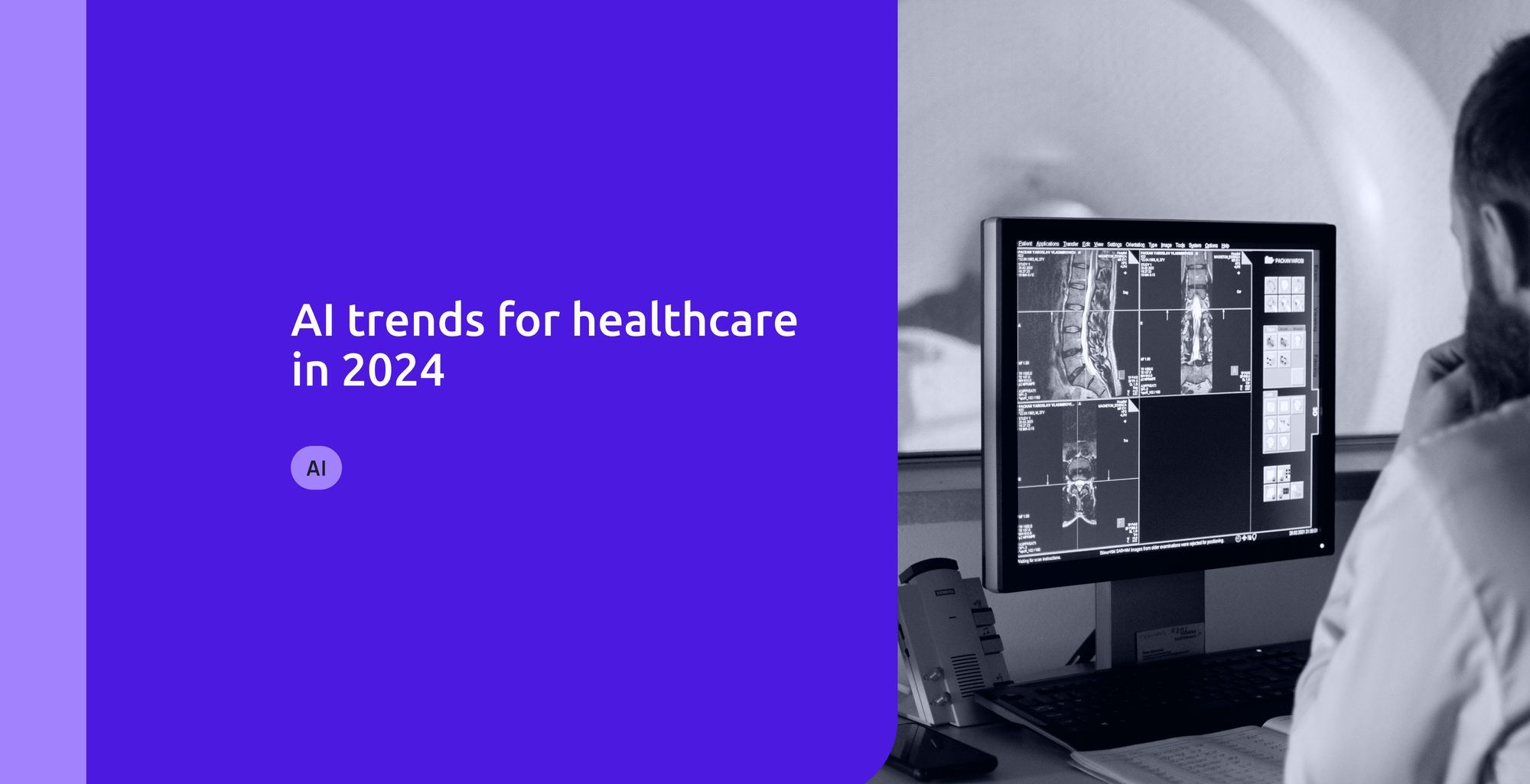At Light-it, we’ve been relying on and getting acquainted with an extensive amount of scientific literature to understand the impact of AI in the healthcare industry while we continue to work on disruptive digital health solutions.
For many, the healthcare industry is the most laborious but inefficient industry in the economy. On another note, it also entails 30% of the world's data. Think about that combination: from how payments in healthcare are administered on the back end to how healthcare is delivered by clinicians in terms of clinical decision support and drug development.
AI has been around for a long time, but in practice, the shiniest solutions haven’t scaled right away. Their potential to improve our healthcare system is taking years to materialize. In 2023, AI was, for sure, the main character in every conversation regarding healthcare technology and the digital health ecosystem. Why? Because it’s become more accessible and this made people more aware of it, so they want to understand it, explore it, and test it. And along came the Generative AI explosion and its massive impact. Let’s explore its applications and implications…

Market Size Evolution
First, let's take a minute to recognize this industry's incredible progress before digging into the many AI trends in healthcare. According to Statista, the market for AI-enabled healthcare was valued at $11 billion in 2021 and is expected to reach an incredible $187 billion by 2030. This enormous advance is unheard of. For background, the global healthcare sector generates an astounding $9 trillion in revenue yearly, or 11% of the world's GDP.
A staggering $3.41 billion in equity fundraising over 278 rounds was secured by AI in Healthcare in 2023, making headlines. This incredible inflow of capital highlights the enormous promise and potential that artificial intelligence has for revolutionizing the healthcare industry.
AI Trends in Healthcare Predictions Facing 2024
AI, especially Generative AI momentum, is taking up in the new year. So, let’s break down the most prominent AI trends in healthcare that healthcare researchers, technologists, and clinicians expect to evolve in the coming year. We aim to help you stay ahead of the curve with this in-depth analysis!
1. Unlocking The Potential Of Large Language Models (LLMs) In Healthcare
Artificial intelligence that mimics human intelligence in the form of large language models (LLMs) can play a key role in healthcare settings by improving the experiences of both patients and providers, streamlining procedures, and even cutting costs. LLMs can be used in healthcare and in digital health products in many ways, such as companions for mental health, virtual health coaches, and interactive patient data-gathering tools, among others.
LLMs as Mental Health Companions
LLMs may be helpful, nonjudgmental companions for mental health at any time of day, lending a sympathetic ear and insightful advice. People may feel more comfortable sharing their experiences and struggles in a secure place created by the empathic reactions of LLMs and the nonjudgmental nature of computers. LLM companions are available around the clock and can provide reliable support in addition to conventional therapy.
Virtual Health Coaches
By using behavioral health strategies, LLMs can serve as virtual health coaches who help patients follow their treatment programs. They can help monitor symptoms, reiterate drug schedules, promote physical activity, and more. This improves the efficacy of care while also improving the patient experience by offering ongoing, one-on-one assistance.
Interactive Patient Data Gathering Tools
Using LLMs instead of conventional forms can make data collecting more interactive and user-friendly. To make sure the material given is accurate and comprehensive, LLMs can assist patients throughout the process by offering comments, clarifications, examples, and further context. This interactive method makes the process of submitting data more interesting and less intimidating, which not only improves the quality of the data but also the experience of the patient.
2. Keyboard liberation and EHR Optimization
Something we’ve been talking about a lot is the concept that’s been coined: keyboard liberation. This addresses the aim of getting clinicians away from their computers and back in front of patients, where they really want to be. There are a number of use cases in development with AI Scribes as one of the most promising technologies to be deployed at scale to reach a large scale in the healthcare industry. This also involves message drafting, text, and chart summarization.
This trend comprises EHR optimization through fully integrated, consumer-friendly tools that help reduce call volume and alleviate repetitive, manual workflows. Forward-thinking, healthcare organizations will more proactively seek healthcare innovation partners to augment their EHR capacities through fully integrated digital tools that can eliminate laborious, manual processes, leading to more effective operations and improved staff and patient involvement.
Clinicians spend a significant amount of time performing routine tasks that can be automated. By automating these repetitive tasks, clinicians can spend more time with their patients during encounters, leading to better quality care. There are -many- humans making really laborious, monotonous tasks that can be automated. They are pretty mundane but very important. AI will shift services to more software administration regarding how software is delivered.
3. Addressing Medical Staff Shortage Crisis
Long, we’ve heard about medical staff burnout and staffing shortages. The World Health Organization predicts that there will be a shortage of 10 million health workers worldwide by 2030. We will start using generative AI in the upcoming year to address the healthcare workforce shortage in a safe and scalable way. Imagine if we had an endless supply of nurses to manage chronic care for everyone on the planet. This degree of "super-staffing" can only be achieved by generative AI.
4. Predictive and Preventive AI Tools for Healthcare
This trend involves using text and images. Getting an instant summarization from clinical research and documentation will help us understand where we’re missing care and what should be done to deliver more care to entire populations. Identifying trends and patterns in unstructured data improves the prediction of at-risk patients.
Preventive health covers many topics, including exercise, wellness, and immunizations however, it all comes down to the proverb that says, “It’s better to avoid than to cure”. In 2024, healthcare providers will prioritize this strategy change from reactive to proactive approaches. Studies have indicated that it can result in long-term advantages for patients and lower the expenses related to treating avoidable illnesses. Here, too, technological advancements like wearables and artificial intelligence (AI) will be crucial in enabling early warning, quick action, risk context notification delivery, and behavioral change health techniques.
5. Drug Discovery and Clinical Trial Participation Improvement
In the biopharma industry, AI integrates multiple-scale advances. It will directly accelerate drug discovery by enabling target discovery. Integrating large-scale datasets from the molecular to the cellular to the tissue scales will enable us to discover the most powerful targets that we need to address in drug discovery efforts. It consists of understating more efficiently and rapidly whether a patient qualifies for a clinical trial. Developing clinical trials in an automated way will show which might be the missing opportunities to promptly deliver potential life-saving drugs.
6. An Even More Profound Personalized Experience for Patients
The increasing focus on healthcare democratization, patient empowerment, and engagement will be causing a major shift in the healthcare industry. 80% of consumers are more likely to engage and stick with firms that provide individualized experiences, according to research quoted in Forbes.
In practice, this is increasingly being done with technology and automated data analysis. Using algorithms to better respond to individual patients and personalize care will be a new frontier for AI. It's the responsibility of developers to use data to generate tools and leverage data to cover diversity and, in that way, all members of our communities.
Additionally, in VR, there are opportunities to provide an even more enhanced precision VR therapy based on each individual's biofeedback data, as well as AI-driven group and one-on-one therapy sessions.
As seen in our first trends, Generative AI powered by NLP models may be impactful companions. Addressing it from a personalized point of view can solve loneliness. There is an epidemic of human loneliness that is responsible for causing both severe psychological distress as well as a variety of detrimental health effects. In 2024, geriatric patients, for instance, will spend time with their favorite fictional or non-fictional human, complete with photo-accurate rendering and a voice and personality that is indiscernible from the real thing. This personal confidante will only be concerned with anything the patient wishes to share that particular day.
According to researchers, a tailored approach to healthcare improves patient outcomes and makes better use of medical resources. It will also become more crucial in solving future healthcare concerns.
7. Digital Twins
A digital twin is a virtual representation of a real-world system, item, location, instrument, or procedure. They can be used to simulate anything from a single device, like a needle, to comprehend how it functions under various circumstances to an entire hospital, to comprehend the manner in which services are provided.
To simulate the impact of alterations in medical interventions, prescription drugs, and lifestyle choices, digital replicas of the human body and specific organs have been created by generative AI. By 2024, researchers plan to create a twin of the human brain, which would be perhaps the most intricate digital twin ever imagined. Transitioning to an era of precision medicine will be paramount with AI.
AI Policies Will Shift as Technology Moves Forward
A united international governance committee for all AI that touches the health system will emerge. We need to put processes in place so that tools are ethical, robust, fair, and safe by evaluating that both when we’re doing initial implementations and then longitudinally as we use the tools.
There’s a need to ask the same questions and ensure we have performance metrics and fairness metrics for the ultimate goal of delivering a safe implementation of all AI-powered tools. It will comprise an integration of health system leaders, ethicists, biostatisticians, health equity experts, and policymakers. All are coming together to accompany the challenging process in which emerging technologies will transform the healthcare system. We need to understand the defining principles to make the development and dissemination of AI technology in healthcare responsible.
Conclusion
The revolution in AI healthcare is in full swing. We have the privilege of seeing firsthand how technology can revolutionize healthcare. We understand and defend it; technology will never be able to replace human judgment and clinical knowledge, but for sure, the above-displayed trends will have a real impact on how we deliver healthcare.
The evolution of Artificial Intelligence (AI) is crucial, and we need to provide it on a larger scale. Most of the AI implementations are relatively small, and the industry is moving in that direction. In 2024, we will focus on use cases that have a very high impact but low risk as we continue to learn how to use these tools safely. It's evident that we need to build tools that do not exist yet.
At Light-it, we’re already employing AI and generative artificial intelligence in a number of healthcare initiatives, so we are familiar with its opportunities and, of course, limitations. We are absolutely pushing forward with our Innovation Lab's proactive study and testing of these technologies in the digital healthcare applications we produce! It's about being cautiously aware of its potential to improve people's quality of life. In fact, this is the ultimate goal of any business operating in the health sector.
I'm interested in observing how AI affects the ecosystem as a whole in 2024. It’s a fast-paced -really fast-paced- context, and I guarantee that these trends are merely the tip of the iceberg in this healthcare revolution arena.

